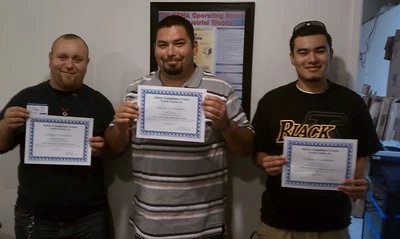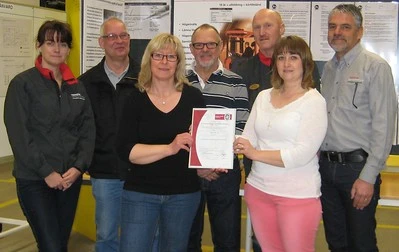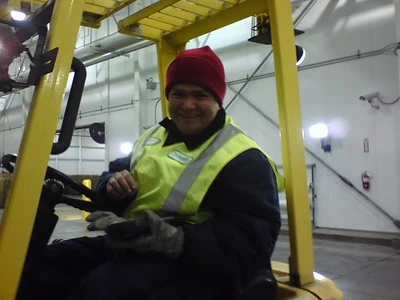Forklift Certification in Alaska (2024 Step-by-Step Guide)
May 8, 2024 | by onlineoshasafetytraining.com


If you work with forklifts in Alaska, getting certified is really important. This certification is not just a piece of paper—it’s your ticket to making sure you can handle a forklift safely and legally. In Alaska, the weather and working conditions can be tough, making it even more crucial to know exactly what you’re doing.
Getting certified means you’re trained to operate forklifts properly, which keeps you and everyone around you safe. Plus, it can even help you land better job opportunities. So, if you’re thinking about driving a forklift, or if your job requires it, getting certified is a smart move.
Here’s what you need to know to do the process…
Who Needs to Be Certified?
Anyone who operates a forklift as part of their job needs to be certified. This requirement ensures that operators have the necessary skills and knowledge to use forklifts safely, reducing the risk of accidents and injuries in the workplace. Here are some specific roles and industries where forklift certification is typically required:

- Warehouse Workers: Employees in warehouses who move goods, organize stock, or load trucks must be certified to operate forklifts safely in these busy environments.
- Construction Workers: On construction sites, forklift operators transport building materials and other heavy items. Certification is crucial for safe operation amidst the varied and often hazardous conditions of a construction site.
- Dockyard Workers: Workers in shipping yards and docks use forklifts to load and unload cargo from ships and containers. Certification is necessary for safely managing heavy loads and navigating the busy, tight spaces of dockyards.
- Manufacturing Employees: In manufacturing settings, forklift operators move raw materials and finished products. They must be certified to ensure they can safely operate around other machinery and personnel.
- Retail Employees: Large retail outlets often employ certified forklift operators to manage stock in storerooms and warehouses, particularly for heavy or bulky items.
- Agricultural Workers: In the agricultural sector, forklifts may be used for moving produce, feed, or farming equipment. Operators in these settings need certification to handle the varied terrain and conditions of farms.
- Logistics and Distribution Operators: This includes those working in distribution centers and logistics hubs where forklifts are essential for moving and organizing goods.
Certification is not just a formal requirement; it’s a crucial part of ensuring that forklift operations do not lead to injuries or fatalities. Training covers practical skills for operating the forklift, as well as safety practices, maintenance basics, and understanding the legal requirements for operating such machinery.
Requirements You Need
To get certified to operate a forklift in Alaska, there are some basic requirements you need to meet and several steps you need to follow. Here’s a simple breakdown:

- Age: The age requirement is straightforward. You must be at least 18 years old to be certified to operate a forklift. This age limit ensures that only adults, who are typically more responsible and have better judgment, are permitted to handle such heavy and potentially dangerous equipment.
- Physical Condition: Being in good physical condition is crucial because operating a forklift involves more than just driving. Operators might need to maneuver heavy loads, react quickly to changes in the environment, and handle long hours of operation. Key physical capabilities include:
- Vision: Good eyesight is necessary to safely navigate the workplace, spot hazards, and manage loads accurately.
- Hearing: Clear hearing helps in detecting warning signals, instructions, or any unusual sounds from the forklift that might indicate mechanical issues.
- Physical Strength and Stamina: Operating a forklift can be physically demanding. Operators might need to climb into the cab, adjust heavy controls, and stay alert for extended periods. Good physical health supports these activities.
- Legal Eligibility: This requirement means you must have the legal right to work in the specific location where the forklift will be operated. This is important because it ties into compliance with local labor laws and regulations. For example, if you are working in the United States, you generally need to have proof of eligibility to work, such as citizenship, permanent residency, or a valid work visa.
These requirements are designed to ensure that forklift operators are responsible, physically capable, and legally permitted to operate in their specific environments, which is key to maintaining safety and compliance in workplaces that use heavy machinery like forklifts.
The Process to Undergo To Get Certified (Step-By-Step)
- Training Program:
- What It Is: This is the first step where you enroll in a formal training program designed to teach you how to operate a forklift.
- Where to Find Programs: These training programs are usually available through employers who use forklifts, as well as at trade schools and community colleges.
- Purpose: The goal is to prepare you for safe operation of forklifts, covering both theoretical knowledge and practical skills.

- Classroom Learning:
- What It Involves: In this phase, you attend instructional sessions in a classroom setting.
- Topics Covered: You learn about the basics of forklift operation, including safety procedures, different types of forklifts (like sit-down, stand-up, pallet jack, etc.), and the specific laws and regulations that govern their use.
- Purpose: This step ensures you understand the foundational knowledge required to operate a forklift safely and legally.
- Practical Training:
- What It Is: This is hands-on training where you actually operate a forklift.
- Setting: Training typically takes place in a controlled environment, like a training facility or a designated area within a workplace.
- Activities: You practice driving the forklift, maneuvering through mock setups that simulate real work environments, handling loads, and performing tasks such as stacking, picking, and moving materials.
- Purpose: The aim is to give you real-world experience in operating a forklift under the supervision of a qualified trainer, allowing you to apply what you’ve learned in the classroom.
- Evaluation:
- What It Involves: After training, you undergo an evaluation that tests your readiness to operate a forklift.
- Components: The evaluation includes a written test to assess your understanding of forklift safety and operation principles, and a practical driving test to demonstrate your ability to safely operate the forklift.
- Purpose: This step verifies that you have acquired the necessary skills and knowledge to handle a forklift safely and are ready to do so in a professional setting.
- Certification:
- What It Is: Upon passing the evaluation, you receive a forklift operator certification.
- Validity: The certification is typically valid for three years, although this can vary depending on local regulations or employer policies.
- Renewal: To maintain your certification, you may need to undergo periodic refresher training or re-evaluation, which ensures that your skills and knowledge are up to date.
- Purpose: Certification formally recognizes that you are qualified to operate a forklift safely and is often required by employers and regulatory bodies.
What Does the Training Contain?
Theoretical Components:
- Safety Training: This covers all aspects of forklift safety, including how to perform daily inspections, understanding the center of gravity and load stability, and recognizing and avoiding hazards in the workplace.
- Operational Instructions: Trainees learn about the different types of forklifts, their parts, and how they work. This includes understanding the controls and instrumentation, starting and stopping procedures, and proper driving techniques.
- Legal Regulations: Participants are taught the legal requirements related to forklift operation, including Occupational Safety and Health Administration (OSHA) standards or other relevant local safety regulations.
- Maintenance Basics: Although not as detailed as the training mechanics receive, operators learn basic maintenance and troubleshooting to ensure the forklift is in good working condition.
Practical Components:
- Hands-On Operation: Trainees actually operate a forklift under supervised conditions. This includes driving, steering, maneuvering, and handling the forklift in various scenarios that mimic real-life situations.
- Load Handling: Practical training also involves learning how to safely handle loads, including picking up, moving, and stacking loads of different sizes and weights, and navigating through narrow and tight spaces.
- Emergency Procedures: Operators are trained on what to do in case of an emergency, such as a mechanical failure or tip-over scenarios.
Duration and Skills Taught:
- Duration: The length of forklift training programs can vary, but most basic courses are completed within one to two days (8 to 16 hours total). More comprehensive training, or training for specific types of forklifts, may take longer.
- Skills Taught: By the end of training, operators are expected to:
- Operate a forklift safely and efficiently.
- Recognize and avoid potential hazards in the workplace.
- Handle loads properly to maintain balance and prevent accidents.
- Perform basic maintenance checks.
- Comply with workplace safety laws and regulations.
Where to Get Certified in Alaska
| Provider Name | Location(s) | Contact Information | Details |
|---|---|---|---|
| Northern Industrial Training, LLC | Palmer, Anchorage, Fairbanks | Palmer: (907) 357-6400, Anchorage: (907) 743-7700 | Offers OSHA-compliant forklift safety courses including hands-on training. |
| Alaska Warehouse Specialists Inc | Anchorage | (907) 222-0900 | Provides OSHA-compliant training with options for groups or individuals. |
| All Purpose Forklift Training | Anchorage, Fairbanks | (888) 978-2516 | On-site training across Alaska, customizable to company needs. |
| EMI Alaska | Statewide | Contact via emi-alaska.com | Offers specialized courses including Powered Industrial Truck Forklift training. |
| ForkliftTraining.com™ | Online | Available online at forklifttraining.com | Online forklift certification and train-the-trainer programs. |
| Liftoff Certifications | Online | Available online at liftoffcerts.com | Offers online forklift operator and recertification courses. |
| All Pro Alaska Forklift | Anchorage | Details at allproak.com | Provides comprehensive forklift and material handling training. |
Tips for Choosing the Right Training Provider:
- Accreditation: Ensure the training provider is accredited and follows OSHA standards.
- Location: Consider a provider that is conveniently located.
- Customization: Look for training programs that offer customization to suit your specific workplace needs.
- Reputation: Check reviews or testimonials to gauge the effectiveness and quality of the training.
Choosing the right training provider is crucial for ensuring you receive quality education and certification that meets safety standards and enhances your operational skills.
Cost of the Training
The cost of forklift training can vary depending on several factors including the provider, the type of training, and the location. Here are some general guidelines based on the information retrieved:
- Northern Industrial Training, LLC – Their forklift safety course costs approximately $225. This course includes both classroom and hands-on training and is designed to meet OSHA standards.
- Alaska Warehouse Specialists Inc – The cost for their classes varies based on the number of participants. For groups of four or more, the cost is $180 per person. If fewer than four participants attend, the price increases to $225 per person.
- All Purpose Forklift Training – They offer customizable on-site training, and the costs might vary depending on the specifics of the training needed. You would need to contact them directly for pricing information.
Generally, live in-person forklift training courses can range from $100 to $300, potentially even higher depending on the provider and the specifics of the training program.
For the most accurate and up-to-date information, it’s best to contact the training providers directly. They can provide specific details on the costs associated with their programs, any available discounts, and what the training includes.
How Long is the Training
Generally, the duration of forklift training can vary depending on the specific program and provider, but here are some typical ranges:

- Short Programs: Basic forklift training sessions, which might focus primarily on safety and basic operation, can last anywhere from 3 to 5 hours. These are often intended for refreshers or initial familiarization.
- Standard Programs: Many comprehensive forklift training courses that include both classroom instruction and hands-on operation typically last about one full day, or approximately 8 hours. This duration is common for programs designed to meet OSHA standards and provide full certification.
- Extended Programs: For more extensive training, which might include specialized types of forklifts or more advanced operational skills, the training could extend to multiple days. For example, a course might span over two to three days if it includes detailed instructions on various types of forklifts, maintenance, and advanced safety protocols.
Each program aims to ensure operators are fully prepared and certified to handle forklifts safely and effectively in their specific work environments. For the most accurate details on training durations, it’s best to consult directly with the training provider or check their specific course descriptions.
Salary of Forklift Operators in Alaska
As of April 24, 2024, the average salary for a Fork Lift Operator in Alaska is about $45,843. However, depending on factors like which city you’re in, your education level, how many additional skills you have, and how long you’ve been in the field, salaries can range from $41,198 to $51,964. This means that how much you earn can vary quite a bit based on your personal experience and where you work.
To get a job as a forklift operator, here’s what you need to do:
- Get Certified: Before you start applying for forklift jobs, you need to have a forklift certification. This is like a special license that proves you know how to safely operate a forklift. You can get this training from places like Northern Industrial Training, LLC or All Purpose Forklift Training. These courses usually teach you both the rules of safe driving and give you some practice driving a forklift.
- Use Job Search Websites: There are websites like Indeed, ZipRecruiter, and Glassdoor where companies post job openings. You can use these sites to look for forklift operator jobs in Alaska. You can search by job type and location, so you can find jobs that are close to where you live or in areas you are willing to work.
- Check Local Companies: Directly visiting or checking the websites of companies that might use forklifts is a good strategy. These could be warehouses, construction companies, or manufacturing plants. Sometimes, jobs are not advertised widely, so asking around at these places might uncover some job openings.
- Work With Staffing Agencies: These are companies that help other businesses find employees. If you tell a staffing agency that you are a certified forklift operator looking for work, they can help match you with a job. They often know about job openings that are not listed anywhere else.
- Network: Talking to people who already work in industries that use forklifts can also lead to job opportunities. This can be friends, family, or even other workers you meet while getting your certification. Sometimes, knowing the right person can help you find out about a job before it’s advertised to the public.
To Make a Conclusion
Getting a forklift certification in Alaska is a smart move for anyone planning to operate a forklift. This certification not only teaches you how to safely handle a forklift but also makes sure you’re up to speed with the laws and safety rules you need to follow. Whether you’re in Anchorage, Fairbanks, or anywhere else in the state, there are places you can go to get trained and certified.
Remember, being certified not only keeps you safe on the job but also boosts your chances of getting better job opportunities. So, if you’re thinking about working with forklifts, taking the time to get certified is definitely worth it.
RELATED POSTS
View all


